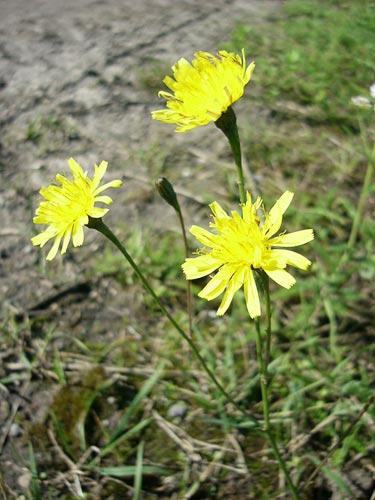Weeds
Crepis tectorum L. - Hawk's-Beard, Narrow-Leaved Hawk's-Beard.
Systematic position.
Family Asteraceae, genus Crepis L.Biological group.
Annual winter weed.Morphology and biology.
Root vertical, strongly branchy. Stalk mostly single, 7-90 cm in height, erect, costate, coreless, branchy, foliaceous, green, sometimes violet from below, weakly pubescent along whole length. Radical and lower stem leaves lanceolate, emarginate-serrate, 2-20 mm in length, gradually narrowed to very short leafstalk, slightly arachnoid-villous, early withering. Middle stem leaves sessile, usually amplexicaul, having small sharp auricles at base, linear, entire. Upper stem leaves have reflexed upward margins and are rough. Capitula multifloral; positioned on thin, slightly bent, incrassate under capitulum pedicles; to 7 mm in length; aggregated in paniculate-corymbose or corymbose inflorescences. Involucre green, 4-5 mm in width and 7-9 mm in length; its leaflets grayish-downy, with sparse blackish glandular hairs; outer leaflets linear-subulate, spreading, unequal in length, 2-3 times shorter than inner ones; inner leaflets are pointed, equal-sized, and covered with appressed hairs on inner side. Flowers yellow, 1.5 times longer than involucre. Corolla 10-13 mm in length. Fruits are elongate-cylindrical, dark brown hemicarps, which are strongly narrowed upward, covered with small spinules in the upper half, having 10 ribs. Pappus white, 4-6 mm in length. Blossoming in June - September. Fertility is 16 thousand (maximum 50 thousand) hemicarps. Shoots appear from autumn, wintering as small rosettes. Plants die off the next year after fruiting.The weed varies strongly in the form and partition of leaves, in height and branching of stalks, and in amount of capitula.Distribution.
Almost all Europe, the Northeast part of Dzungaria, Mongolia (North), China (Northeast), all Siberia to Pacific coast, Central Asia (North Balqash Lake Basin).Ecology.
Prefers light soils and insolated places. The minimal temperature for germination is 2-4°C (optimum +20 - +22°C); sprouts from a depth of no more than 3-4 cm.Economic significance.
Hemicarps of the Hawk's-Beard strongly litter soil, but can be removed from seed grain. It is the main weed of winter cereals, less often weed of summer grain-crops (rye, wheat), perennial grasses, and tilled crops. Control measures include destroying stubble, autumn plowing with correct subsequent spring treatment, cleaning seed grain, inter-row treatment on tilled crops, use of herbicides if necessary.Reference citations:
Komarov, V.L., ed. 1959. Flora of the USSR. Moscow & Leningrad: AN SSSR. V. 25: 557-558. (In Russian)Tikhonova Z.E. 1937. Weeds and their control. Gor`kii: Gor`kii Regional Publishing House. 110 p. (In Russian)
Tolmachev, A.I., ed. 1977. Flora of North-East of the European part of the USSR. Leningrad: Nauka. V. 4: 312. (In Russian)
Veselovs.kii I.V., Lisenko A.K., Man.ko Yu.P. 1988. Atlas-synopsis of weeds. Kyiv: Urozhai. 66 p. (In Ukrainian)


